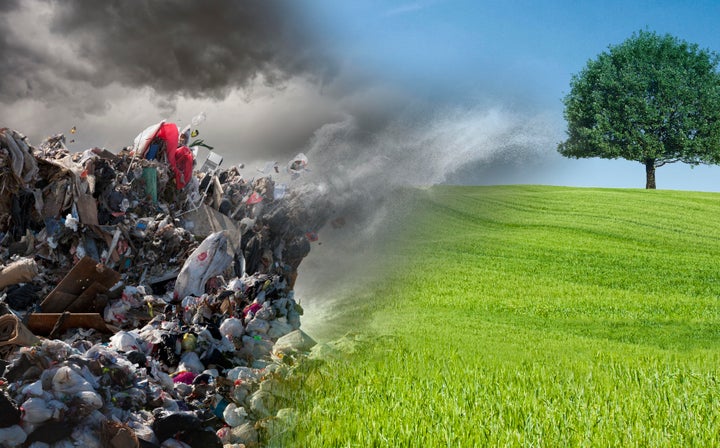
There’s an idea for a world without trash.
Items are not just recycled, but created with the intention of making new things out of them after they are used. Imagine if every pair of Levi’s jeans were manufactured with fibers made to be pulled apart and repurposed into a new pair of jeans after the old ones are cast off. The cycle repeats itself endlessly, meaning old jeans become new jeans, rather than being chucked into a landfill.
This is the promise of the “circular economy,” a metaphorical description of a world where nothing ever needs to be discarded because goods are designed with materials that can be constantly remade into something else. It's important to note that the concept is pretty theoretical at this point. There are companies that are working on making their operations more circular -- even big ones like Walmart -- but no one yet can claim to have a business free of waste.
Proponents call our current production model the “linear model,” meaning goods are manufactured with the intention of being thrown away at the end of their useful life. Not only does most of what we buy on a daily basis end up getting tossed out, but all the materials used to make and package our stuff get discarded, too. Think about the plastic packaging -- just the packaging -- of the products sold in most stores.
If things keep going this way, by 2025 the ocean will contain a ton of plastic for every three tons of fish, according to a report on rethinking plastics by the Ellen MacArthur Foundation, a circular economy-focused think tank. By 2050, the ocean could have more plastic than fish, by weight.
Many people believe making manufacturing and energy use more circular is a solution to a world that is consuming far more than it can sustain, in a way that doesn't reject the basic tenets of capitalism. Theoretically, the circular economy would save the planet, without having to change consumer behavior much.
“Today’s economy is hugely wasteful. The circular economy completely takes waste out of the system by changing the design principles,” says Martin Stuchtey, a former director of McKinsey’s Center for Business & Environment who recently left the consulting firm to start his own company focused on the circular economy.
Making products circular requires businesses to rethink the way they create -- from an item's first conceptual design, through the manufacturing process, to the end of the product's useful life and, hopefully, to its reuse.
But that's easier said than done. The idea mentioned above about jeans that come apart to be made into new jeans? Levi Strauss and Co. is working on it, but it's still in the research stage. The company on Wednesday announced a partnership with a textile startup called Evrnu, with which it's created a single prototype pair of jeans "made from regenerated post-consumer cotton waste."
Levi's also has a partnership with a company called I:Collect, which takes used clothes collected at Levi's storefronts worldwide and recycles them into building insulation and cushioning material.
Part of this relies on the people who buy jeans also committing to returning them when they're no longer wanted, according to Michael Kobori, the vice president of sustainability at Levi Strauss. "Consumers are a critical part of achieving a circular economy," he told The Huffington Post. "To take old jeans and turn them into new products, we need the jeans!"
Stuchtey -- whose London-based firm, SystemiQ, will invest in companies that are trying to make their businesses circular -- didn't have a ton of details to share because his venture is still very new. He did tell HuffPost that he is working with a million-hectacre project in Indonesia that will focus on the problem of plastics in the oceans, and with another venture that is trying to expand the use of hydrogen energy.
Stuchtey spent 20 years at McKinsey and eight working on environmental issues, particularly focusing on water resources. Looking into the root causes of environment and resource issues, he told HuffPost, increasingly led him to “zero-waste thinking.”
Stuchtey describes a circular economy as one without a lot of individual ownership, particularly when it comes to durable goods -- things like your car, your refrigerator and even your phone. Companies would own products and lease them to consumers, then be responsible for reusing or recycling those products after the consumer has finished using them. Circularity is not just about saving the planet -- it’s about profiting while doing so.
In some ways, that is what we are moving toward. Think about transportation, for instance. The biggest news in transportation right now is car services like Uber and Lyft. Their vision is to eventually replace individual car ownership with fleets of self-driving taxis. The goal is to make using an Uber or Lyft car for all your vehicle needs cheaper than actually owning your own car. In some major cities, that's already true, provided you never want to go on a road trip.
Stuchtey calls these companies circular -- because they enable a world that uses fewer cars -- although he admits that the cars themselves are not perfectly circular. Car parts might be able to be repurposed, but eventually they become junk.
And, of course, for every company trying to move toward a less wasteful manufacturing process, there are multiple companies building more wasteful products than ever. (Say hello to the Keurig for tortillas.)
"The late version of the old system is trying to outcompete the first manifestation of the new system," said Stuchtey. "For every good example that we see, we see one, if not two, if not three, where we are getting more linear and less reusable. The average doesn’t show a good picture. You have to think of it as a race of two different tracks."
